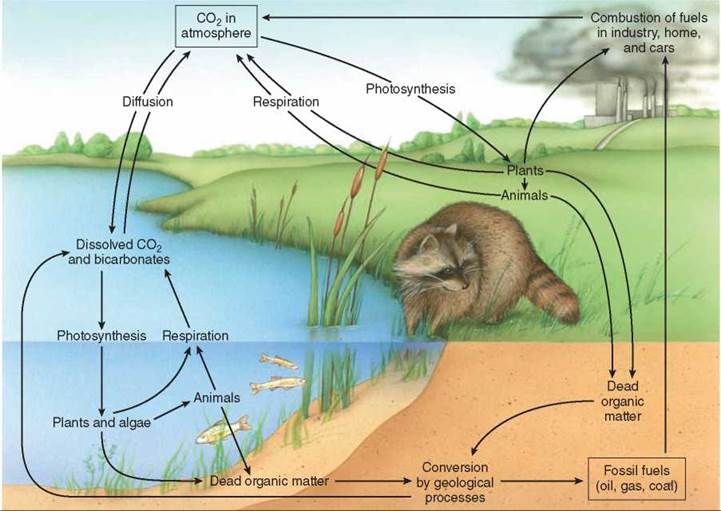THE LIVING WORLD
Unit Eight. The Living Environment
The earth’s atmosphere contains plentiful carbon, present as carbon dioxide (CO2) gas. This carbon cycles between the atmosphere and living organisms, often being locked up for long periods of time in organisms or deep underground. The cycle is begun by plants that use CO2 in photosynthesis to build organic molecules—in effect, they trap the carbon atoms of CO2 within the living world. The carbon atoms are returned to the atmosphere’s pool of CO2 through respiration, combustion, and erosion. The carbon cycle, seemingly more complex than the water cycle, is shown in figure 36.8.

Figure 36.8. The carbon cycle.
Carbon from the atmosphere and from water is fixed by photosynthetic organisms and returned through respiration, combustion, and erosion.
Most of the organisms in ecosystems respire—that is, they extract energy from organic food molecules by stripping away the carbon atoms and combining them with oxygen to form CO2. At times, plants respire, as do the herbivores, which eat the plants, and the carnivores, which eat the herbivores. All of these organisms use oxygen to extract energy from food, and CO2 is what is left when they are done. This by-product of respiration is released into the atmosphere.
Combustion
A lot of carbon is tied up in wood, and it may stay trapped there for many years, only returning to the atmosphere when the wood is burned or after it decomposes. Sometimes the duration of the carbon’s visit to the organic world is long indeed. Plants that become buried in sediment, for example, may be gradually transformed by pressure into coal or oil. The carbon originally trapped by these plants is only released back into the atmosphere when the coal or oil (called fossil fuels) is burned.
Erosion
Very large amounts of carbon are present in seawater as dissolved CO2. Substantial amounts of this carbon are extracted from the water by marine organisms, which use it to build their calcium carbonate shells. When these marine organisms die, their shells sink to the ocean floor, become covered with sediments, and form limestone. Eventually, the ocean recedes and the limestone becomes exposed to weather and erodes; as a result the carbon washes back and is dissolved in oceans where it is returned to the cycle through diffusion.
Key Learning Outcome 36.4. Carbon captured from the atmosphere by photosynthesis is returned to it through respiration, combustion, and erosion.